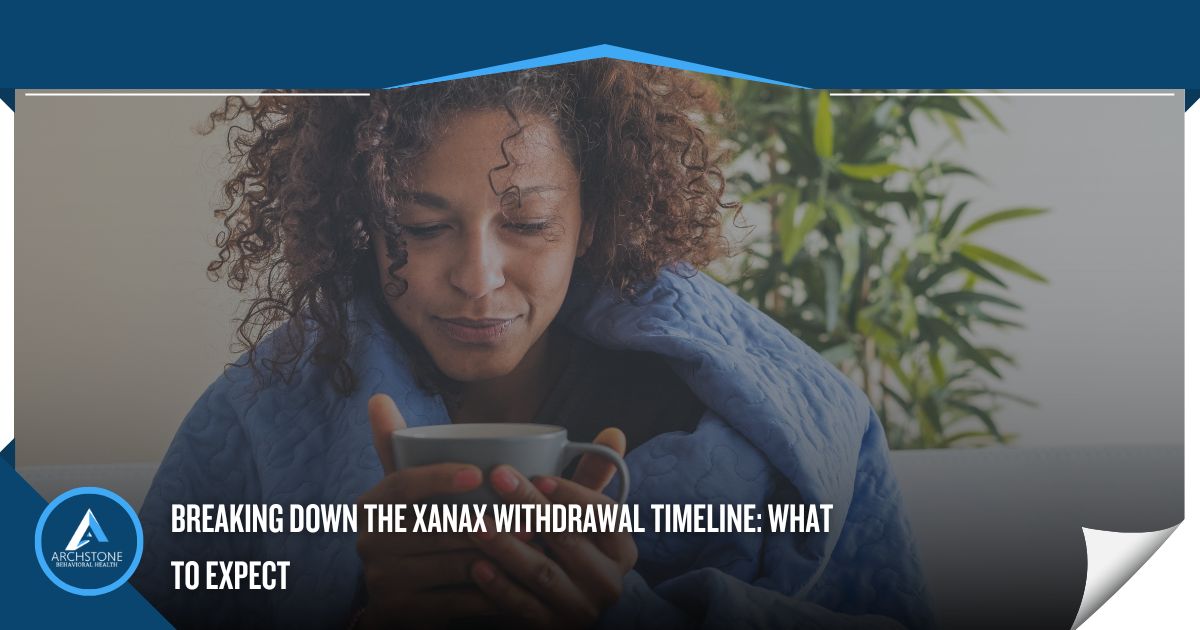Breaking Down the Xanax Withdrawal Timeline: What to Expect
Get Help Now

Xanax is a commonly prescribed medication that has a high risk for abuse and addiction. Even those taking it as prescribed may develop tolerance and addiction to Xanax. The risk for complications and addiction is increased in those taking it recreationally (without a prescription).
If you or someone in your life misuses Xanax or takes it recreationally, it’s essential to understand the risk of addiction and seek treatment immediately. Knowing what to expect during Xanax abuse treatment can help you feel more confident when seeking treatment.
This article will explore what happens during Xanax withdrawal, including common symptoms and a typical Xanax withdrawal timeline. Reach out to the team at Archstone Behavioral Health to learn about our Xanax abuse treatment programs or to schedule an intake assessment.
What is Xanax?
Xanax is the brand name for a drug called alprazolam. It is one of the most commonly prescribed benzodiazepine medications in the United States and the most common psychotropic drug in the country. Doctors prescribe Xanax to help patients reduce and manage the symptoms of anxiety and panic disorders, which include:
- Agitation
- Interrupted sleep
- Gastrointestinal symptoms
- Poor memory and concentration
- Racing thoughts
Anxiety and panic disorders can keep people from feeling comfortable and managing daily activities.
Mental health specialists believe that chronic anxiety is caused by an imbalance of chemicals in the brain, including a decrease in a neurotransmitter called Gamma-aminobutyric acid (GABA). GABA slows activity in the brain and reduces hyperactivity. Xanax works by increasing the brain’s production of GABA and making more of it available. As a result, people who take Xanax experience fewer symptoms of anxiety and notice improvements in their ability to function throughout the day.
Xanax can produce feelings of calm, relaxation, sedation, and euphoria. These pleasant effects can make people want to take more Xanax than prescribed or use it recreationally. However, prolonged or heavy Xanax use can lead to physical and psychological dependence and addiction.
Xanax Withdrawal
When someone who has been using Xanax heavily suddenly stops taking it, they will likely experience a range of uncomfortable side effects, including:
- Insomnia
- Sweating
- Agitation
- Loss of appetite
- Tremors
- Nausea
- Irritability
Some people may develop more serious side effects, including seizures and suicidal thoughts and behaviors during Xanax withdrawal. It’s crucial to seek supervision and treatment during Xanax withdrawal to avoid severe or life-threatening complications during the detox process.
What to Expect During the Xanax Withdrawal Timeline
The Xanax withdrawal timeline can vary from person to person and depends in part on the severity of their substance use, mental and medical health history, body composition, and other personal factors. However, the following outlines a typical Xanax withdrawal timeline.
24-72 hours
Xanax withdrawal symptoms usually develop within 24 hours of your last dose and are the most severe for the first one to three days. Many people experience intense psychological and physical symptoms during the earliest stages of Xanax withdrawal, including:
- Nausea
- Vomiting
- Elevated heart rate
- Insomnia
- Mood swings
The risk for seizures is highest during the first 72 hours of the Xanax withdrawal timeline. Assessment, supervision, and treatment are essential during this stage.
One week
Xanax withdrawal symptoms remain uncomfortable for at least a week. People typically experience:
- Racing heart
- Insomnia
- Irritability
- Intense cravings
People may also develop depression and anxiety during this stage. Supervision, emotional support, and ongoing treatment are essential to help people avoid relapse due to cravings and to ensure safety.
Two weeks
As physical withdrawal effects dissipate and the risk for seizures decreases, psychological symptoms may intensify. Anxiety, depression, insomnia, and cravings continue and may get worse.
Three to four weeks
Anxiety may increase or intensify among those who have been taking Xanax to manage anxiety and panic disorders. Physical symptoms are often gone by this point in the Xanax withdrawal timeline, but headaches and heightened senses may continue to cause discomfort. Insomnia may begin to resolve during this stage, but people may continue to struggle with sleep for a long time after detoxification is complete.
It takes your body about a week to clear Xanax from the system, but withdrawal symptoms can remain for weeks–or even months–afterward. Having professional treatment and support is essential to ensure you can get through each stage of the Xanax withdrawal timeline without relapsing.
Find Support During Xanax Withdrawal
Xanax withdrawal can be mentally and physically challenging. It’s crucial to find the treatment, emotional support, and supervision you need to get through each stage of withdrawal so that you can achieve your goal of sobriety and work toward lifelong recovery from Xanax addiction.
If you or someone you love needs help to get through Xanax withdrawal, you are not alone. Reach out to the caring team at Archstone Behavioral Health now to learn about our holistic detox and treatment programs or to schedule an intake assessment.
